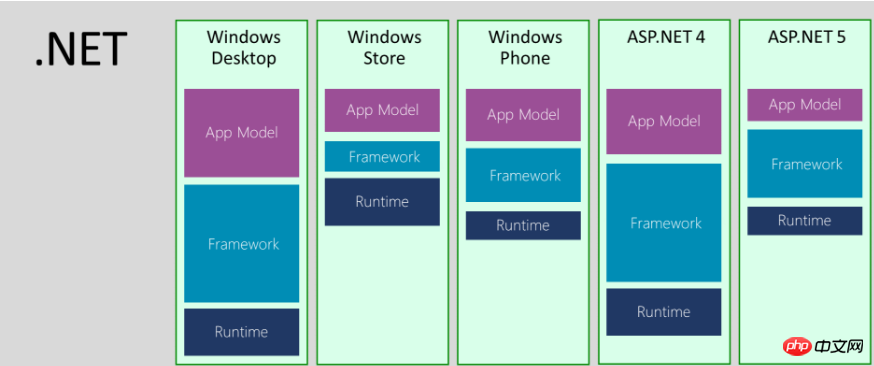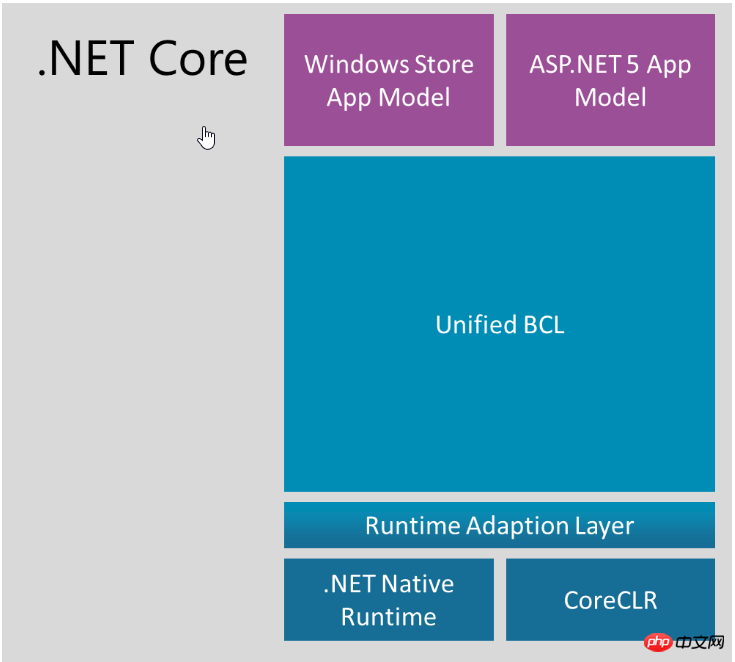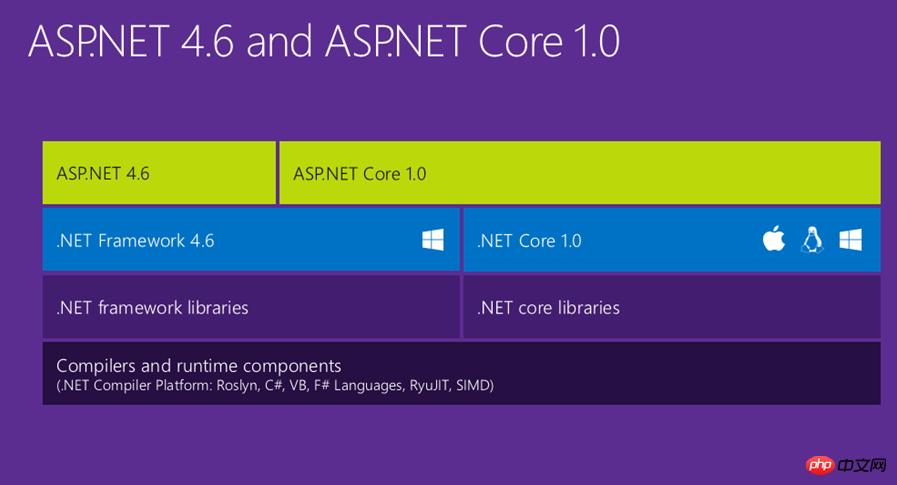
Detailed analysis of .NET Core and its relationship with .NET Framework (picture):
To understand .NET Core, there is It is necessary to understand the many Frameworks of the previous .NET platform. In 2002, Microsoft released the first .NET framework - .NET Framework. Soon after, it released .NET Compact Framework for use on smaller mobile devices (Windows mobile), and .NET Compact Framework also contains a It is similar to the .NET Framework system (Runtime, Framework, Application Model), which is a simplified Detailed analysis of .NET Core and its relationship with .NET Framework (picture) of the .NET Framework. Over the past few years, Microsoft has continuously launched several frameworks similar to the .NET Framework to run on different devices and platforms. Each Framework has a similar system but not exactly the same, so there are more and more Frameworks. For developers, different devices need to maintain multiple sets of codes even if they have the same functions, which increases the complexity of development.

Microsoft’s rethinking and improvement of these issues allowed .NET Core to emerge.
.NET Core is an open source modular Framework. Whether developing web or mobile devices, they all run under the same Framework (.NET Core), and .NET Core can also run on different operating systems. Running, including Windows, Linux, MacOS, achieving cross-platform and cross-device.
What’s even better is that .NET Core does not need to install the Framework in advance when publishing the program but downloads it through Nuget. In this way, there is no need to install a complex and huge Framework during the initial deployment, but it is downloaded on demand. This Nuget-based on-demand loading makes .NET Core cross-platform.

.NET Core composition system is as follows:
There are two types of RunTime implemented in .NET Core, NativeRuntime and CoreCLR. NativeRuntime converts C# or VB.net code directly into native machine code. CoreCLR is an open source JIT runtime that compiles the code into an intermediate language (IL) and then converts it into machine code at final runtime.
Base Classlibrary is the basic class, such as FileSystem, Console, XML operations, etc.
Provides a set of basic libraries for developing various touch screen devices and Detailed analysis of .NET Core and its relationship with .NET Framework (picture) programs for Windows systems.



Detailed analysis of .NET Core and its relationship with .NET Framework (picture) Core Web Application(.NET Core)
Detailed analysis of .NET Core and its relationship with .NET Framework (picture) that depends on .NET Core can only call the API of .NET Core and can run on multiple operating systems. run.(You can see the Reference Manager in the lower half of the picture below, there is no library in the .NET Framework in the assemblies)
Detailed analysis of .NET Core and its relationship with .NET Framework (picture) Core Web Application (.NET Framework)
Detailed analysis of .NET Core and its relationship with .NET Framework (picture), which relies on .NET Core & .NET Framework, can call the API of .NET Core & .NET Framework and can only run under Windows. (You can see the Reference Manager in the upper part of the figure below, which contains all the libraries in the .NET Framework in the assemblies)
Microsoft CEO Satya Nadella wisely decided to abandon PC-centricity, embrace various devices and platforms, and become a software services company. In order to achieve this vision, a new Microsoft ecological chain must be built, including Windows, Linux, OS X and other operating systems, covering processors such as X86/ARM and different devices (including PCs, Phones, holographic glasses and others). These show Microsoft's "ambition". With the official release of .NET Core taking a solid step forward, let us wait and see on June 27.
The above is the detailed content of Detailed analysis of .NET Core and its relationship with .NET Framework (picture). For more information, please follow other related articles on the PHP Chinese website!
 Windows cannot complete formatting hard disk solution
Windows cannot complete formatting hard disk solution
 Cryptocurrency exchange rankings
Cryptocurrency exchange rankings
 How to use the Print() function in Python
How to use the Print() function in Python
 Mobile phone encryption software
Mobile phone encryption software
 Why can't the Himalayan connect to the Internet?
Why can't the Himalayan connect to the Internet?
 Where to buy Bitcoin
Where to buy Bitcoin
 Why the computer keeps restarting automatically
Why the computer keeps restarting automatically
 How to read carriage return in java
How to read carriage return in java




